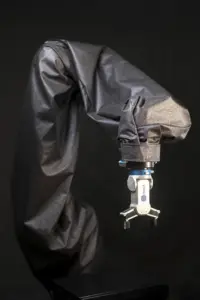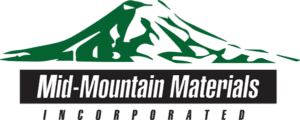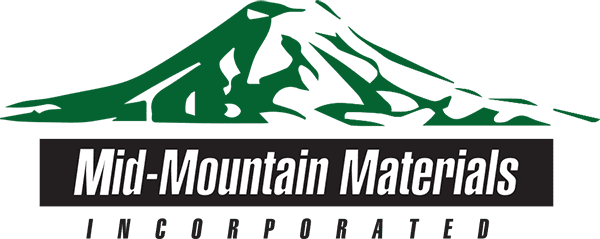Robots play an increasingly significant role in modern industry, often finding application in areas that are unsafe for human workers. This puts them at risk of exposure to corrosion, heat damage, abrasion and other types of exposure-related damage, which can dramatically reduce operational lifetime. THERMOPAK® Robot Covers from Mid-Mountain Materials offer a robust and cost-effective solution, enabling manufacturers to protect robots from harsh conditions and maximize their value.
Robots and Industry
Robotics and industry feed into each other: they share common goals and motives, and the two are becoming increasingly intertwined. The first robots were developed to perform industrial tasks, and much of the technology that makes modern robots reliable and adaptable has emerged from industrial robotics.1 Today, industrial robotics remains one of the key drivers in the advancement of industry, and many anticipate that robots are bringing about a fundamental shift in manufacturing akin to a fourth industrial revolution.2
Capable of operating with superhuman speed and precision, robots excel at performing repetitive manufacturing tasks which may be difficult or even impossible for human workers to carry out. These include welding, forging, sandblasting, electronics manufacturing and countless other applications across virtually all industrial and manufacturing sectors.
Despite high capital costs, the immense value of automating industrial processes means that the uptake of robots is increasing rapidly. The global robotics industry is now estimated to be worth over $100 billion, a figure which is expected to double by 2025.3 A report from the International Federation of Robotics showed a record-breaking 2.7 million industrial robots operating in factories around the world in 2020, with sales of new robots remaining at a high level.4
Degradation of Industrial Robots
For all their strength and resilience, robots aren’t entirely immune to damage. As robots continue to be adapted into demanding industrial roles – in chemical processing, surface treatment and foundry applications – it is increasingly apparent that harsh operating conditions can cause rapid degradation of robotic equipment.
The causes of robot degradation are numerous. High temperatures are one major contributing factor: increasing electrical resistance and causing the breakdown of lubricants, elevated temperatures cause thermal expansion effects, which can wreak havoc with gearing and sensor performance.5 This is particularly challenging for robots deployed in foundries, where high convected and radiant heat levels are a constant threat.
Moisture is another common culprit, causing corrosion of critical motion systems in robots, which happens especially quickly at high temperatures. Corrosion from other chemicals, such as acids, can be even worse – this remains a significant obstacle to the integration of robots into certain processes in the chemical industry.
In surface treatment applications, robots can easily fall prey to abrasion from abrasive blasting media such as sand or steel shot. This type of mechanical wear can even be a problem for robots in other applications, where small particles of dust and other atmospheric particulates can clog and/or damage joints and other moving parts.
These types of degradation don’t need to have obvious results to be harmful: even a minor loss of accuracy in tool center position (TCP), for example, can have dramatic negative effects within the context of a complex manufacturing environment.6
Protecting Robots from Damage

Robots are an investment, and decisions over automation often hinge on being able to extract the maximum lifetime value from very expensive robotic equipment. Minimizing robot degradation, therefore, plays a crucial role in enabling industrial applications of robots.
The most versatile and cost-effective means of doing so is to protect robotic equipment with coverings. Coverings are easy to implement, straightforward to replace; making them a versatile and cost-effective way of protecting against all the major causes of degradation.
The choice of material from which coverings are constructed is crucial. For example, a waterproof polymer covering may provide protection from moisture ingress and subsequent electrical failure, but poor protection against abrasion.
The specific challenges of robot degradation protection led Mid-Mountain Materials, Inc. to develop a unique solution that is resilient against corrosion, abrasion and high temperatures, while providing total ingress protection.
Our ARMATEX® SBN 13-602 ROBOTEX consists of an ultra-high-strength aromatic polyamide woven fabric coated with a high-performance silicon elastomer. Offering exception strength and high flexural failure resistance, we use this material to manufacture bespoke THERMOPAK® Robot Protective Covers to suit all industrial robotics applications.7
Our unique composite textile is designed specifically to meet the needs of robotic equipment in harsh operating conditions. It offers excellent resistance to a wide range of fluids and chemicals, while also offering very high resistance to flexural failure and abrasion.
High thermal conductivity and unique physical properties ensure excellent high-temperature performance: THERMOPAK® Robot Covers offer high flexibility, which is practically unaffected by temperature. Both tensile and tear strength remain exceptionally high even after thermal exposure.
By protecting robots from harsh operating conditions, THERMOPAK® Robot Covers drastically reduce downtime and maintenance costs, increasing ROI and maximizing our customers’ investments in robotics. Vertical integration of both the fabrication and coating processes ensures that Mid-Mountain can rapidly provide bespoke THERMOPAK® Robot Covers to suit any industrial application. Robot covers can be produced in various colors to designate the function of different robots, and can be enhanced for robots with wide ranges of motion such as those that kneel as well as stand.
To find out more about our high-performance protective coverings for industrial robots, get in touch with the Mid-Mountain team today – we’ll be happy to hear from you.
References and Further Reading
1. Hägele, M., Nilsson, K., Pires, J. N. & Bischoff, R. Industrial Robotics. in Springer Handbook of Robotics (eds. Siciliano, B. & Khatib, O.) 1385–1422 (Springer International Publishing, 2016). doi:10.1007/978-3-319-32552-1_54.
2. What is Industry 4.0? https://www.ibm.com/uk-en/topics/industry-4-0 (2021).
3. How 2020 catalyzed the rise of the robots. TechHQ https://techhq.com/2020/11/how-2020-catalyzed-the-rise-of-robots/ (2020).
4. IFR. IFR presents World Robotics Report 2020. IFR International Federation of Robotics https://ifr.org/ifr-press-releases/news/record-2.7-million-robots-work-in-factories-around-the-globe.
5. Environmental effects on motion components in robots. https://www.motioncontroltips.com/motion-components-and-environmental-effects-on-robot-performance-and-life/.
6. Qiao, G. & Weiss, B. A. Quick health assessment for industrial robot health degradation and the supporting advanced sensing development. J Manuf Syst 48, 10.1016/j.jmsy.2018.04.004 (2018).
7. Robot Protection Covers | Mid-Mountain Materials. https://mid-mountain.com/protecting-robotic-equipment-in-extreme-environments/.

